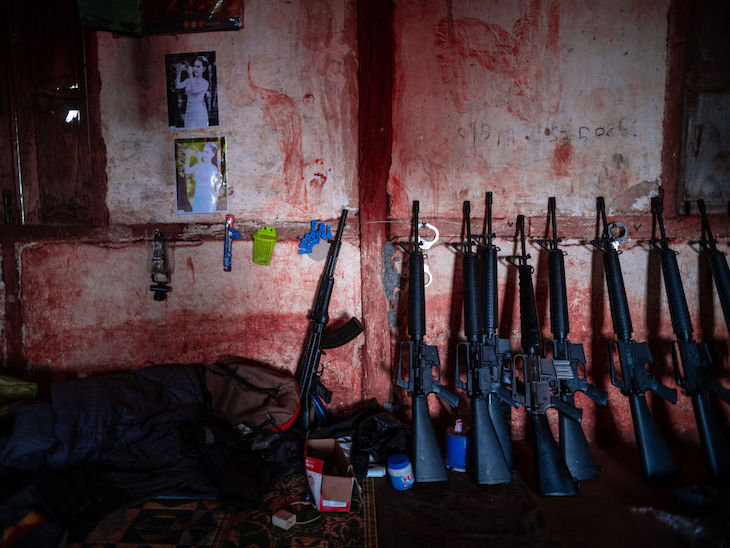A Myanmar military jet continued to fly sorties just over our hidden frontline hospital. Every time it screamed low over the tree line, the entire clinic would crouch down and pray that this wouldn’t be the strike that hit us. These hospitals are prime targets; the military has no qualms about bombing groups of wounded fighters and civilians alike.
Myanmar’s civil war has reached its most volatile and fragmented stage since the coup
I was on the frontlines in Karenni State, at the township of Bawlakhe, where the resistance was launching a large, multi-pronged offensive to seize one of the most strategically important towns in the region. The two main medics running the emergency ward were a husband and wife in their early 30s, former hospital workers who quit after the 2021 coup and joined the rebellion. They’ve seen four years of relentless war. The military deliberately murders its own people.
I’ve seen firsthand the destruction the regime’s airstrikes cause. While the world looks away as conflict breaks out in the Middle East, at least 6,231 civilians have been killed in Myanmar, including 1,144 women and 709 children, according to figures published in January that were compiled by the Assistance Association for Political Prisoners (AAPP) and the United Nations. By late June, AP News reported that the number had climbed even higher, with more than 6,600 civilians killed in the aftermath of the coup. These numbers reflect a systematic campaign of violence, targeting not only resistance forces, but ordinary people caught in the crossfire.
Karenni forces – primarily the Karenni Nationalities Defense Force (KNDF), the Karenni Army, and allied ethnic militias – have maintained strong momentum in Kayah (Karenni) State. Since mid-March 2025, they’ve pushed a major offensive to retake Bawlakhe, capturing key junta outposts, seizing weapons, and tightening the noose on the military’s last holdouts. The fighting has been fierce, with heavy casualties on both sides, and the junta responding with devastating artillery and airpower.
Myanmar’s civil war has reached its most volatile and fragmented stage since the coup. Resistance forces have gained unprecedented ground across ethnic and central regions, while the junta – once largely in control – is now stretched thin. It is relying heavily on airstrikes, forced conscription, and scorched-earth tactics to maintain its grip on a handful of key cities. Meanwhile, a patchwork of ethnic armed groups and pro-democracy militias have captured strategic towns, border crossings, and infrastructure, effectively governing vast areas of the country.
Death and despair are constant on the front. But within that chaos, you also glimpse the raw resilience of the resistance. Despite facing a heavily-armed military backed by China and Russia, these young fighters stare down their enemy with fury and focus.
‘Even when the warplanes are flying low, we must stay calm and keep our composure,’ Bu Boo told me towards the end of the day. ‘If we show that we are nervous or alarmed, the other soldiers and medics will start to lose their composure too.’
His wife, known as Yo Yo, is just as unshakable. The scene inside the hospital was chaos, yet the medics moved with calm, almost instinctual precision. Every five to ten minutes, an injured fighter was rushed into the base.
I could hear the screech of tires as another Toyota pickup pulled up outside, just a couple of kilometers from the front. Bu Boo triaged each case quickly, determining who had the best chance of surviving. Some of the men had gaping holes in their bodies. Others lay limp with collapsed lungs, unable to speak.
‘Look at me. Stay awake. Don’t close your eyes!’ a fighter shouted at his comrade, who was drifting out of consciousness. He had taken shrapnel just under his left ear. His blood soaking through a ragged uniform. Yo Yo managed to stop the bleeding and ordered an immediate transfer to a better-equipped hospital further from the battle line. A few men lifted him into a pickup that served as transport for both the wounded and the dead.
After the fighting calmed briefly, a heavy silence fell over the camp. The exhaustion was visible in everyone’s faces. Some of the resistance fighters, not yet 25, looked aged beyond their years after four straight years of war.
But when you ask them about the future, they light up. For them, there is no other path. They must win. This generation refuses to live in the dark, like their parents and grandparents once did. They’ve experienced peace before. They know the potential of their country. And they understand that to get it back, they must fight. They must defeat the junta.
At the time of writing, the Karenni resistance was still locked in battle for Bawlakhe, a town whose fall could trigger the full liberation of Kayah State. If they win, other major towns may follow in a domino effect.
The battle for Bawlakhe has become a symbol of what’s possible when fractured resistance groups unite with shared purpose. Across Karenni State, fighters from once-separate brigades now operate under a joint command, planning ambushes, sharing intelligence, and caring for each other’s wounded.
Several key junta positions have already fallen, and the resistance is now pressing deeper into the heart of the township. The junta has unleashed relentless air and artillery strikes, torching villages and sending waves of newly conscripted troops into the fight. But it is clear that this regime is no longer fighting from a position of dominance. Many believe it is fighting to survive.
The fall of Bawlakhe, when it eventually happens, would mark a turning point in the war in Karenni State, a moment that signals to the rest of the country that the junta can be beaten not just in the mountains, but in the towns it once held with impunity.







Comments